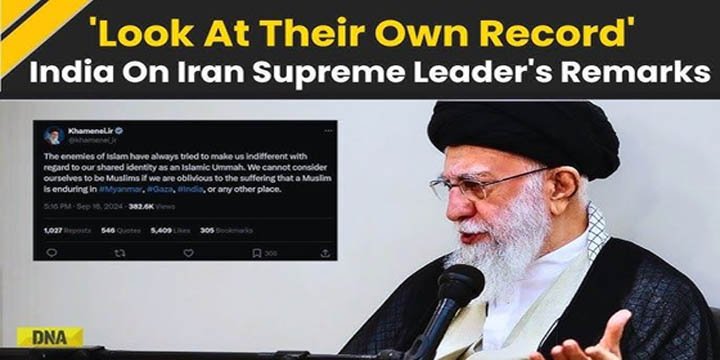IRAN’S SUPREME LEADERS REMARKS ON STATUS OF MUSLIMS IN INDIA
On September 16, 2024, Ayatollah Ali Khamenei, Iran’s Supreme Leader, made remarks about Muslims in India that led to a strong reaction from New Delhi.
This incident comes amid a backdrop of long-standing India-Iran relations, which have been affected by geopolitical and economic factors, including Western sanctions on Iran.
THE REMARKS
- Statement: To mark Eid-e-Milad-un-Nabi (Prophet Muhammad’s birth anniversary), Khamenei wrote on X (formerly Twitter):
- “The enemies of Islam have always tried to make us indifferent to our shared identity as an Islamic Ummah. We cannot consider ourselves to be Muslims if we are oblivious to the suffering that a Muslim is enduring in Myanmar, Gaza, India, or any other place.”
- He also commented on Iran, suggesting that “ill-wishers have been fuelling religious differences in the Islamic world, especially in Iran.”
INDIA’S REACTION
- Government Response: The Ministry of External Affairs (MEA) of India strongly condemned Khamenei’s remarks. MEA spokesperson Randhir Jaiswal stated:
- “We strongly deplore the comments made regarding minorities in India by the Supreme Leader of Iran. These are misinformed and unacceptable. Countries commenting on minorities are advised to look at their own record before making any observations about others.”
- Coincidental Timing: The condemnation coincided with the second anniversary of Mahsa Amini’s death, a significant event in recent Iranian history. Amini’s death in 2022 led to widespread protests in Iran and ongoing civil unrest.
ABOUT INDIA-IRAN RELATIONS
Background
- Historical Ties: India and Iran share a rich history of cultural and commercial interactions dating back centuries. They shared a border until 1947 and have many common features in language, culture, and traditions.
- Diplomatic Relations: Formal diplomatic relations were established on March 15, 1950, with the opening of embassies in Tehran and New Delhi.
Diplomatic Engagements
- High-Level Visits: Frequent high-level visits have enhanced bilateral cooperation. Notably, Prime Minister Narendra Modi’s visit to Iran in 2016 strengthened diplomatic ties and underscored mutual interests.
Economic Cooperation
- Trade Relations:
- Bilateral Trade Growth: In FY 2022-23, India-Iran bilateral trade was $2.33 billion, marking a 21.76% year-on-year increase.
- Export and Import: India’s exports to Iran totaled $1.66 billion (14.34% growth YOY), while imports from Iran were $672.12 million (45.05% growth YOY).
- Energy Partnership:
- Oil Imports: India was a major importer of Iranian oil, which is crucial for its energy needs. India stopped importing Iranian oil due to western sanctions.
- Chabahar Port: Developed with Indian investment, this port is vital for trade and energy supplies and is part of the India-Iran-Afghanistan Trilateral Agreement.
- Shahid Beheshti Port: In May 2024, India signed a long-term contract for operating the Shahid Beheshti Port terminal at Chabahar in Iran, marking the first instance of India managing an overseas port.
- Investment Initiatives:
- Sectoral Interests: Indian companies are interested in investing in infrastructure, petrochemicals, and manufacturing sectors in Iran.
Strategic Partnerships
- Chabahar Port:
- Strategic Importance: Provides India with an alternative trade route bypassing Pakistan, enhancing connectivity to Afghanistan and Central Asia.

-
-
- INSTC: A key component of the International North-South Transport Corridor (INSTC), which connects India to Europe via Iran and Central Asia.
- Economic and Geopolitical Impact: Facilitates diversification of trade routes, enhances energy security, and counters Chinese influence in the region.
-
- Security Cooperation:
- Regional Security: Collaborative efforts to counter terrorism and extremism, reflecting shared security concerns.
Recent Agreements and Initiatives
- Farzad-B Gas Field: India’s interest in developing this gas field highlights ongoing energy cooperation.
- Banking and Financial Agreements: Efforts to establish mechanisms to facilitate trade despite international sanctions, reflecting the resilience of economic ties.
- Health Diplomacy: Joint efforts during the COVID-19 pandemic, including the provision of medical supplies and collaborative research initiatives, underscore the relationship’s resilience in global crises.
CHALLENGES
- International Sanctions:
- Impact of Sanctions: Iran’s nuclear program has led to various international sanctions, limiting economic cooperation and impacting trade and investment.
- CAATSA: The Countering America’s Adversaries Through Sanctions Act (CAATSA) complicates relations by imposing sanctions on countries engaging in significant transactions with Iran, affecting India’s strategic autonomy.
- Nuclear Cooperation and JCPOA:
- JCPOA Challenges: The Joint Comprehensive Plan of Action (JCPOA) aimed at limiting Iran’s nuclear program, faced complications after the U.S. withdrawal in 2018. This has impacted Iran’s economy and affected India’s energy imports.
- Energy Dependency and Geopolitical Pressures:
- Balancing Act: India’s dependence on Iranian oil and geopolitical dynamics, particularly pressure from the U.S., create challenges in maintaining a balanced relationship.
- Regional Security Dynamics:
- Conflicts and Rivalries: Ongoing conflicts and rivalries in the Middle East, such as those in Syria and Yemen, impact bilateral relations.
- Challenges in Chabahar Development:
- Delays and Obstacles: The development of Chabahar Port has faced logistical and financial delays, impacting its strategic potential.
- Terrorism and Security Concerns:
- Security Threats: Both nations confront terrorism and extremism, which can strain security cooperation.
- Cultural Misunderstandings:
- People-to-People Relations: Despite historical ties, occasional cultural misunderstandings can strain interactions between the populations.
- Divergent Regional Priorities:
- Focus Areas: India’s focus on economic development and Iran’s security concerns can sometimes lead to divergent priorities.
- Geostrategic Competition:
- Regional Influence: Intense geopolitical competition in the region adds complexity to India-Iran relations.
- US-India Relations Impact:
- Diplomatic Balance: India’s relationship with the U.S., particularly concerning U.S.-Iran dynamics, influences its interactions with Iran.
Note: Connect with Vajirao & Reddy Institute to keep yourself updated with latest UPSC Current Affairs in English.
Note: We upload Current Affairs Except Sunday.


